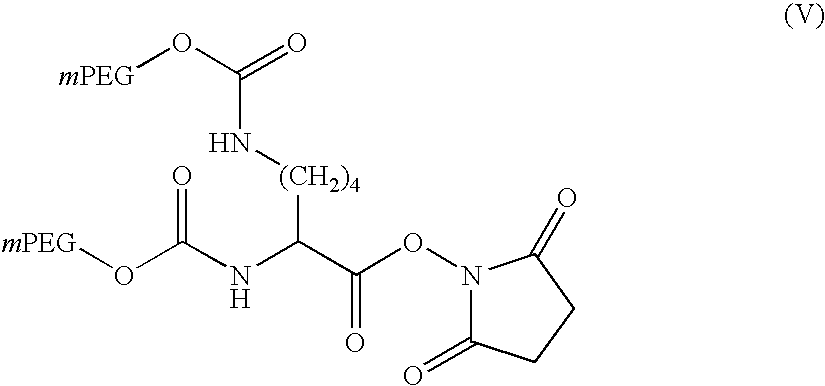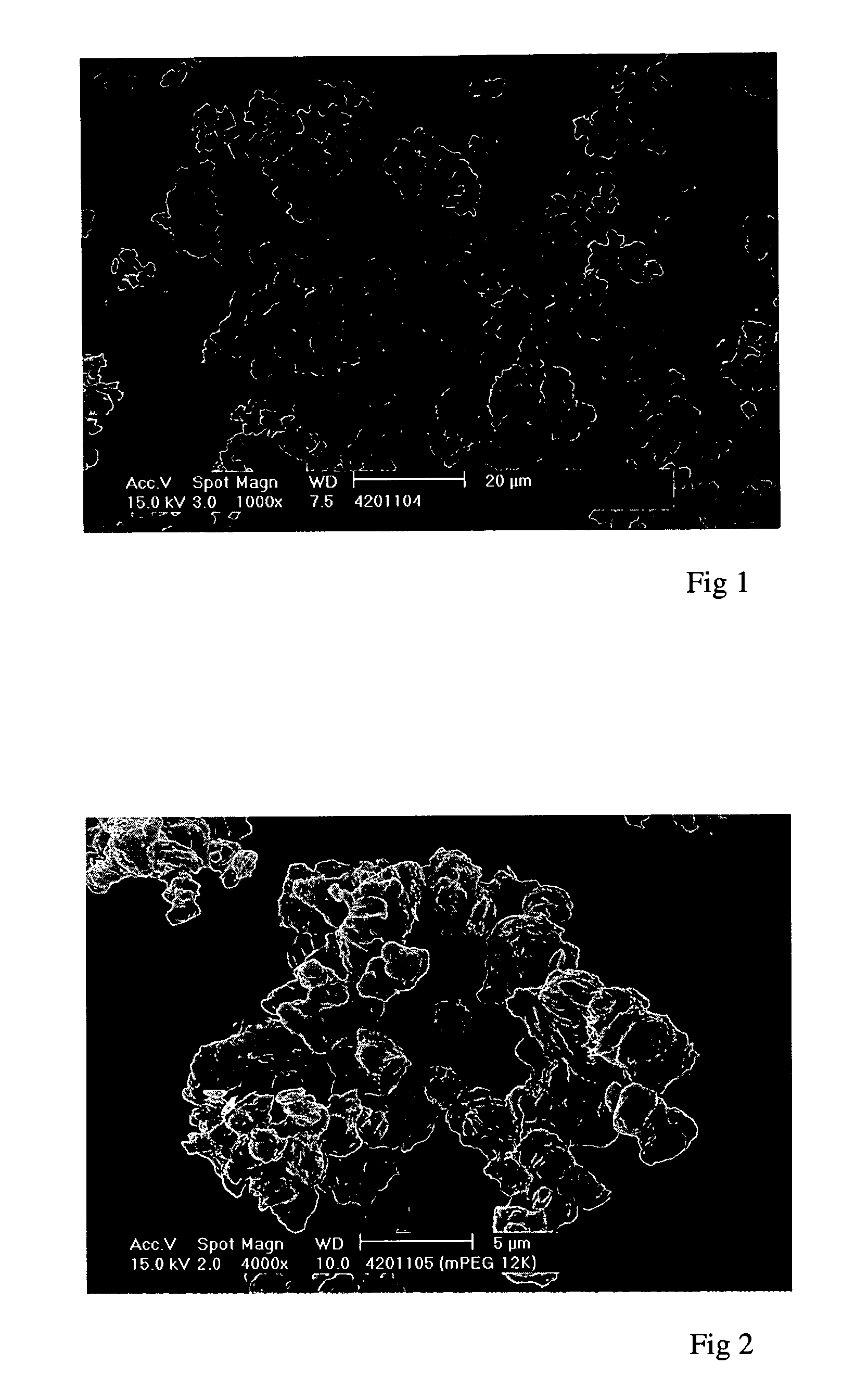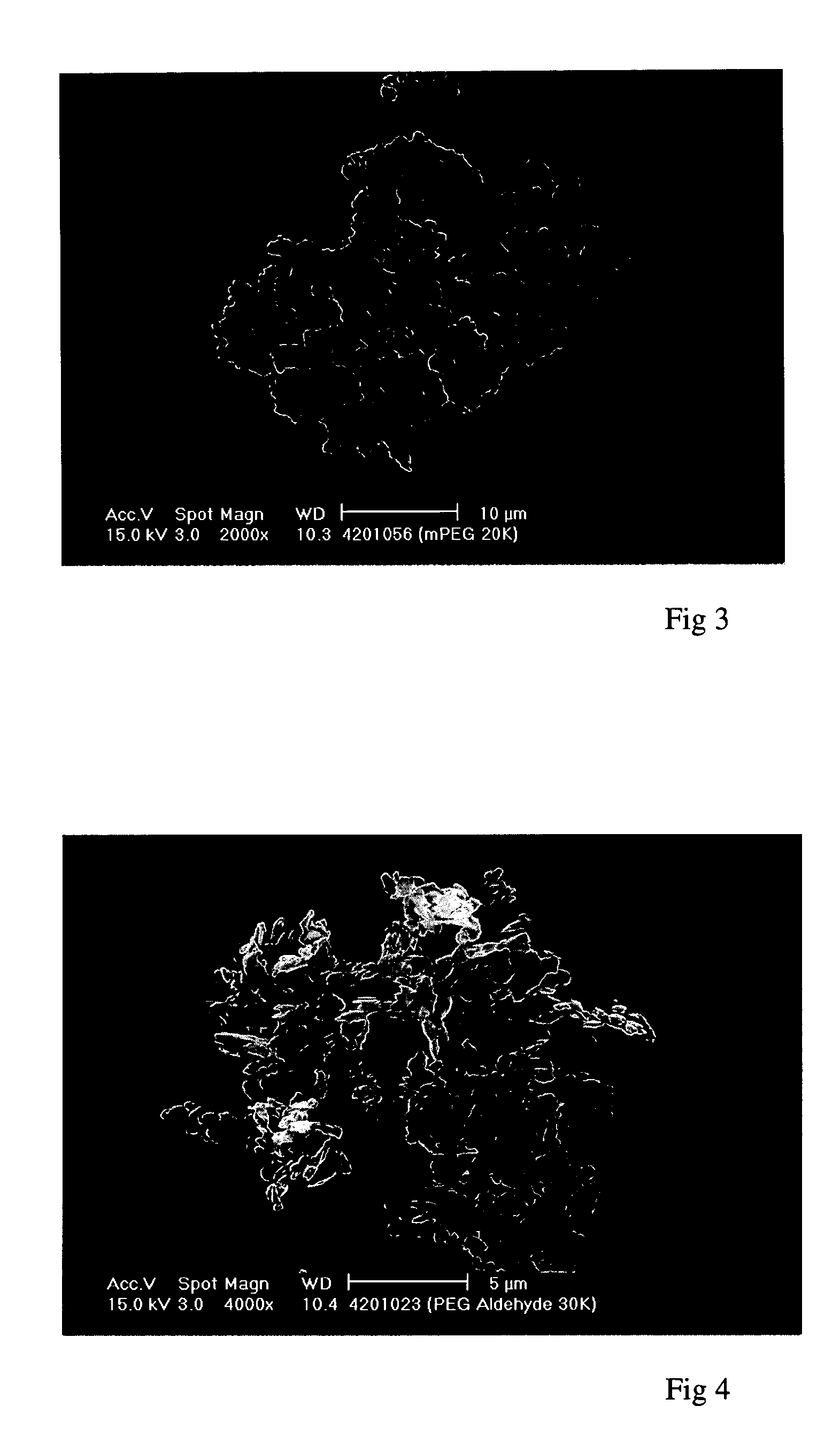Particle formation
- Summary
- Abstract
- Description
- Claims
- Application Information
AI Technical Summary
Benefits of technology
Problems solved by technology
Method used
Image
Examples
examples 1
[0163] Linear PEGs of formula (I) (R.sup.1=methyl), of different molecular weights, were successfully precipitated using a Nektar.TM. SCF-type process according to the method of the invention.
[0164] The 5 kDalton (.+-.500 dalton) PEG starting material had a particle size of 27.3 .mu.m and a melting point of 64.degree. C. and contained .ltoreq.1% of the non-methylated base diol. The 12 kDalton (.+-.1200 dalton) starting material had a particle size of 35.1 .mu.m and a melting point of 65.7.degree. C. and contained .ltoreq.1.5% of the non-methylated diol. The 20 kDalton (.+-.200 dalton) PEG starting material had a particle size of 46.9 .mu.m, a melting point of 66.6.degree. C. and a diol content of .ltoreq.3%.
[0165] The CO.sub.2 flow rate was 20 ml / min (measured at the pump head), that for the target solution 0.1 ml / min. A 50 ml particle formation vessel was used.
[0166] Different solvents and target solution concentrations were tested, as set out in Table 1 below, together with the pr...
examples 2
[0169] These experiments demonstrate the precipitation, using a Nektar.TM. SCF-type method according to the invention, of an "activated" PEG. The starting material was a linear PEG of formula (II) in which R.sup.1=methyl and X=CHO (at least 80% aldehyde groups, ie, .ltoreq.20% unactivated PEG). It had a molecular weight of 30 kDaltons (.+-.3,000 dalton), a particle size of 55.6 .mu.m and a melting point of 59.9.degree. C. It contained residual solvents DCM and isopropyl alcohol (IPA) in total amounts less than 100 ppm, however these levels had been achieved by oven drying. It had the form of agglomerated flakes.
[0170] Attempts to precipitate this material from methanol, a methanol / ethanol (1:1) mixture and dichloromethane at supercritical temperatures (80, 60 and 40.degree. C.) did not yield a particulate product, presumably due to the solubility of the PEG in the CO.sub.2 anti-solvent under such conditions. In some cases this resulted in no yield at all, in others the PEG deposited...
examples 3
[0176] In these experiments, a Nektar.TM. SCF-type process was used to precipitate a branched two-arm activated PEG of formula (V) below: 1
[0177] in which mPEG represents a linear PEG chain as defined in formula (I) with R.sup.1 being methyl and --O--R.sup.2 being replaced by the N-hydroxysuccinimidyl ester / amide linkage group. This is a branched PEG of which the two PEG arms are connected via urethane linkages to a lysine linker activated as the N-hydroxysuccinimide ("NHS") ester, ie, mPEG2-N-hydroxysuccinimide.
[0178] The activated PEG has a total molecular weight of 40 kDaltons (20 kDaltons for each mPEG arm). Its "apparent" molecular weight is expected to reflect that of each arm, ie, in this case 20 kDaltons (.+-.4,000 dalton). The starting material had a particle size of 33.5 .mu.m and a melting point of 60.9.degree. C., and contained the residual solvents DCM and IPA in total amounts less than 100 ppm.
[0179] It was precipitated from DCM (15% w / v; solution flow rate 0.1 ml / min)...
PUM
| Property | Measurement | Unit |
|---|---|---|
| Temperature | aaaaa | aaaaa |
| Fraction | aaaaa | aaaaa |
| Fraction | aaaaa | aaaaa |
Abstract
Description
Claims
Application Information
 Login to View More
Login to View More - R&D
- Intellectual Property
- Life Sciences
- Materials
- Tech Scout
- Unparalleled Data Quality
- Higher Quality Content
- 60% Fewer Hallucinations
Browse by: Latest US Patents, China's latest patents, Technical Efficacy Thesaurus, Application Domain, Technology Topic, Popular Technical Reports.
© 2025 PatSnap. All rights reserved.Legal|Privacy policy|Modern Slavery Act Transparency Statement|Sitemap|About US| Contact US: help@patsnap.com



